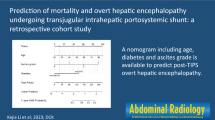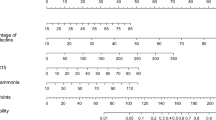Abstract
Background and aims
The selection of appropriate candidates for transjugular intrahepatic portosystemic shunt (TIPS) is important and challenging. To validate the Model for End-Stage Liver Disease (MELD) 3.0 in predicting mortality in patients with cirrhosis after TIPS creation.
Methods
A total of 855 consecutive patients with cirrhosis from December 2011 to October 2019 who underwent TIPS placement were retrospectively reviewed. The prognostic value of the MELD 3.0, MELD, MELD-Na, Child–Pugh and FIPS score was assessed using Harrell’s C concordance index (c-index). The Hosmer–Lemeshow test was used to test the goodness of fit of all models and the calibration plot was drawn.
Results
The c-index of the MELD 3.0 in predicting 3-month mortality was 0.727 (0.645–0.808), which were significantly superior to the MELD (0.663 [0.565–0.761]; P = 0.015), MELD-Na (0.672 [0.577–0.768]; P = 0.008) and FIPS (0.582 [0.477–0.687]; P = 0.015). The Child–Pugh score reached c-indices of 0.754 (0.673–0.835), 0.720 (0.649–0.792), 0.705 (0.643–0.766) and 0.665 (0.614–0.716) for 3-month, 6-month, 1-year, and 2-year mortality, respectively, which seems comparable to MELD 3.0. A MELD 3.0 of 14 could be used as a cut-off point for discriminating between high- and low-risk patients. The MELD 3.0 could stratify patients with Child–Pugh grade B (log-rank P < 0.001). The Child–Pugh score could stratify patients defined as low risk by MELD 3.0 (log-rank P < 0.001).
Conclusions
The MELD 3.0 was significantly superior to the MELD, MELD-Na and FIPS scores in predicting mortality in patients with cirrhosis after TIPS creation.



Similar content being viewed by others
References
Rössle M. TIPS: 25 years later. J Hepatol. 2013;59:1081–1093. https://doi.org/10.1016/j.jhep.2013.06.014.
de Franchis R, Baveno VIF. Expanding consensus in portal hypertension: report of the Baveno VI Consensus Workshop: stratifying risk and individualizing care for portal hypertension. J Hepatol. 2015;63:743–752. https://doi.org/10.1016/j.jhep.2015.05.022.
Bettinger D, Schultheiss M, Boettler T, Muljono M, Thimme R, Rössle M. Procedural and shunt-related complications and mortality of the transjugular intrahepatic portosystemic shunt (TIPSS). Aliment Pharmacol Ther. 2016;44:1051–1061. https://doi.org/10.1111/apt.13809.
Sarwar A, Zhou L, Novack V, Tapper EB, Curry M, Malik R et al. Hospital volume and mortality after transjugular intrahepatic portosystemic shunt creation in the United States. Hepatology 2018;67:690–699. https://doi.org/10.1002/hep.29354.
Ronald J, Wang Q, Choi SS, Suhocki PV, Hall MD, Smith TP et al. Albumin-bilirubin grade versus MELD score for predicting survival after transjugular intrahepatic portosystemic shunt (TIPS) creation. Diagn Interv Imaging 2018;99:163–168. https://doi.org/10.1016/j.diii.2017.10.008.
Sturm L, Praktiknjo M, Bettinger D, Huber JP, Volkwein L, Schmidt A et al. Prognostic value of the CLIF-C AD score in patients with implantation of transjugular intrahepatic portosystemic shunt. Hepatol Commun 2021;5:650–660. https://doi.org/10.1002/hep4.1654.
Young S, Rostambeigi N, Golzarian J, Lim N. MELD or sodium MELD: a comparison of the ability of two scoring systems to predict outcomes after transjugular intrahepatic portosystemic shunt placement. AJR Am J Roentgenol. 2020;215:215–222. https://doi.org/10.2214/AJR.19.21726.
Kim WR, Mannalithara A, Heimbach JK, Kamath PS, Asrani SK, Biggins SW et al. MELD 30: the model for end-stage liver disease updated for the modern era. Gastroenterology. 2021. https://doi.org/10.1053/j.gastro.2021.08.050.
Wiesner R, Edwards E, Freeman R, Harper A, Kim R, Kamath P et al. Model for end-stage liver disease (MELD) and allocation of donor livers. Gastroenterology 2003;124:91–96. https://doi.org/10.1053/gast.2003.50016.
Bettinger D, Sturm L, Pfaff L, Hahn F, Kloeckner R, Volkwein L et al. Refining prediction of survival after TIPS with the novel Freiburg index of post-TIPS survival. J Hepatol. 2021;74:1362–1372. https://doi.org/10.1016/j.jhep.2021.01.023.
Song J, Wang X, Yan Y, Xiang T, Luo X. Validating the prognostic value of Freiburg index of posttransjugular intrahepatic portosystemic shunt survival score and classic scores in Chinese patients with implantation of transjugular intrahepatic portosystemic shunt. Eur J Gastroenterol Hepatol. 2022;34:1074–1080. https://doi.org/10.1097/meg.0000000000002427.
Malinchoc M, Kamath PS, Gordon FD, Peine CJ, Rank J, ter Borg PC. A model to predict poor survival in patients undergoing transjugular intrahepatic portosystemic shunts. Hepatology 2000;31:864–871. https://doi.org/10.1053/he.2000.5852.
Leise MD, Kim WR, Kremers WK, Larson JJ, Benson JT, Therneau TM. A revised model for end-stage liver disease optimizes prediction of mortality among patients awaiting liver transplantation. Gastroenterology 2011;140:1952–1960. https://doi.org/10.1053/j.gastro.2011.02.017.
Galle PR, Forner A, Llovet JM, Mazzaferro V, Piscaglia F, Raoul J-L et al. EASL clinical practice guidelines: management of hepatocellular carcinoma. J Hepatol. 2018;69:182–236. https://doi.org/10.1016/j.jhep.2018.03.019.
D’Amico G, Garcia-Tsao G, Pagliaro L. Natural history and prognostic indicators of survival in cirrhosis: a systematic review of 118 studies. J Hepatol. 2006;44:217–231. https://doi.org/10.1016/j.jhep.2005.10.013.
Kamath PS, Wiesner RH, Malinchoc M, Kremers W, Therneau TM, Kosberg CL et al. A model to predict survival in patients with end-stage liver disease. Hepatology 2001;33:464–470. https://doi.org/10.1053/jhep.2001.22172.
Biggins SW, Kim WR, Terrault NA, Saab S, Balan V, Schiano T et al. Evidence-based incorporation of serum sodium concentration into MELD. Gastroenterology 2006;130:1652–1660. https://doi.org/10.1053/j.gastro.2006.02.010.
Locke JE, Shelton BA, Olthoff KM, Pomfret EA, Forde KA, Sawinski D et al. Quantifying sex-based disparities in liver allocation. JAMA Surg 2020;155:201129. https://doi.org/10.1001/jamasurg.2020.1129.
Allen AM, Heimbach JK, Larson JJ, Mara KC, Kim WR, Kamath PS et al. Reduced access to liver transplantation in women: role of height, MELD exception scores, and renal function underestimation. Transplantation 2018;102:1710–1716. https://doi.org/10.1097/tp.0000000000002196.
Alessandria C, Gaia S, Marzano A, Venon WD, Fadda M, Rizzetto M. Application of the model for end-stage liver disease score for transjugular intrahepatic portosystemic shunt in cirrhotic patients with refractory ascites and renal impairment. Eur J Gastroenterol Hepatol. 2004;16:607–612. https://doi.org/10.1097/00042737-200406000-00015.
Angermayr B, Cejna M, Karnel F, Gschwantler M, Koenig F, Pidlich J et al. Child-pugh versus mELD score in predicting survival in patients undergoing transjugular intrahepatic portosystemic shunt. Gut 2003;52:879–885. https://doi.org/10.1136/gut.52.6.879.
Wang Q, Bai W, Han G. Freiburg index of post-TIPS survival: the first score for individual prediction and a complementary tool for risk stratification. J Hepatol. 2021. https://doi.org/10.1016/j.jhep.2021.05.042.
Kraglund F, Gantzel RH, Jepsen P, Aagaard NK. External validation of the Freiburg index of post-TIPS survival. J Hepatol. 2021. https://doi.org/10.1016/j.jhep.2021.04.027.
Tripodi A, Chantarangkul V, Primignani M, Fabris F, Dell’Era A, Sei C et al. The international normalized ratio calibrated for cirrhosis (INR(liver)) normalizes prothrombin time results for model for end-stage liver disease calculation. Hepatology 2007;46:520–527. https://doi.org/10.1002/hep.21732.
Luca A, Miraglia R, Maruzzelli L, D’Amico M, Tuzzolino F. Early liver failure after transjugular intrahepatic portosystemic shunt in patients with cirrhosis with model for end-stage liver disease score of 12 or less: incidence, outcome, and prognostic factors. Radiology 2016;280:622–629. https://doi.org/10.1148/radiol.2016151625.
Funding
This study was funded by the 1·3·5 project for disciplines of excellence–Clinical Research Incubation Project, West China Hospital, Sichuan University (2019HXFH055) and the Project for Science & Technology Department of Sichuan Province(2020YFH0089).
Author information
Authors and Affiliations
Contributions
This study was designed by XL. Material preparation, data collection and analysis were performed by JS, XW, YY and TX. The first draft of the manuscript was written by JS. All authors read and approved the final manuscript.
Corresponding author
Ethics declarations
Conflict of interest
The authors declare that they have no conflict of interest.
Ethical approval
All procedures performed in studies involving human participants were in accordance with the ethical standards of the institutional and/or national research committee and with the 1964 Helsinki declaration and its later amendments or comparable ethical standards.
Informed consent
Informed consent was obtained from all individual participants included in the study.
Additional information
Publisher's Note
Springer Nature remains neutral with regard to jurisdictional claims in published maps and institutional affiliations.
Supplementary Information
Below is the link to the electronic supplementary material.
10620_2023_7834_MOESM1_ESM.tif
The MELD 3.0 score stratifies patients with Child-Pugh grade B (A). The Child-Pugh score stratifies patients with MELD 3.0 score≤14 (B). Supplementary file1 (TIF 474 kb)
Rights and permissions
Springer Nature or its licensor (e.g. a society or other partner) holds exclusive rights to this article under a publishing agreement with the author(s) or other rightsholder(s); author self-archiving of the accepted manuscript version of this article is solely governed by the terms of such publishing agreement and applicable law.
About this article
Cite this article
Song, J., Wang, X., Yan, Y. et al. MELD 3.0 Score for Predicting Survival in Patients with Cirrhosis After Transjugular Intrahepatic Portosystemic Shunt Creation. Dig Dis Sci 68, 3185–3192 (2023). https://doi.org/10.1007/s10620-023-07834-3
Received:
Accepted:
Published:
Issue Date:
DOI: https://doi.org/10.1007/s10620-023-07834-3




